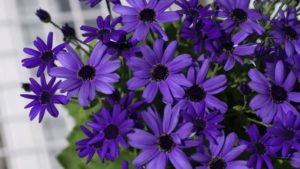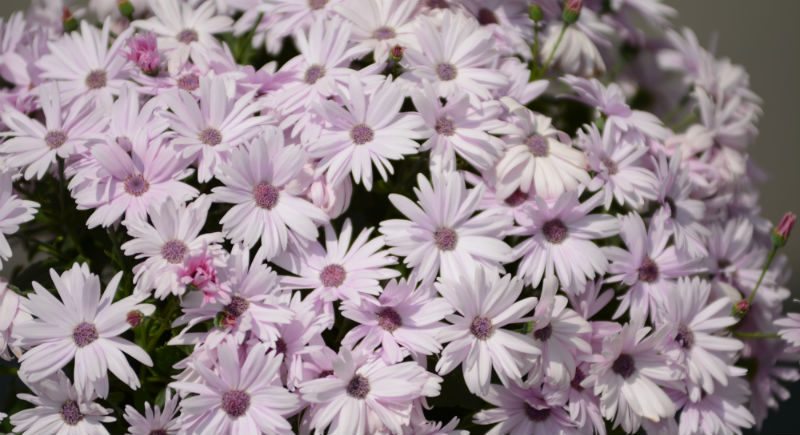
Culture Report: Pericallis Senetti Series
When it comes to early spring color, you can’t beat the Senetti pericallis series from Suntory Flowers. Flower count can be as high as 200 on a plant grown in a 10-inch pot in electric shades of blue, purple, pink and magenta.
Senetti varieties are dramatically different from old-fashioned cinerarias. Although the vivid bicolor flowers look familiar, the cool weather garden performance, durability and vigor Senetti offers is so much better. Plus, Senetti has a unique reblooming ability and can be cut back for a fresh flush of flowers.
Senetti likes it cool and can withstand temperatures as low as 35° F. In addition to the benefits of production energy savings, plants are a natural fit for the early spring sales window. Upright and bushy with excellent branching, Senetti is well suited as an outdoor patio plant in large containers and in beds as a bedding plant.
Go large! Senetti needs room to show its stuff. Plants will be happiest in pot sizes that are 8-inch or larger. You will see the most impressive show and flower count in a larger pot, increasing the opportunity to command a premium price at retail. You want at least 20 flowers for consumers to see the “wow” factor. For smaller pots, choose the Baby Senetti series, which is more compact.

Rooting
Rooting media should have a pH of 5.6 to 5.8. Use a well-balanced fertilizer after roots develop 10 days after sticking. Set air/venting temperature at 75° F and bottom heat at 68° F. Keep humidity high at 90 percent or higher, ensuring cuttings are kept moist and turgid. After 14 days of misting/fogging, cut misting time in half. Air humidity level should be 60 to 70 percent. After 21 days, stop misting. During bright days, shading may be required to protect delicate cuttings.
A week prior to shipping or transplanting, cuttings can be given a soft pinch to encourage a bushy plant.
Senetti isn’t a uniform series and there are noteworthy differences in rooting times among the Senetti varieties. Group 1 (Deep Blue and Blue Bicolor) is fast, about 10 days. Group 2 (Magenta Bicolor, Violet Bicolor, Pink Bicolor and Baby Senetti varieties) takes 14 days. Group 3 (Magenta) is the slowest at 18 days.
Growing On
Transplant rooted cuttings into finish pots in well-drained growing media. Keep pH at 5.6 to 6.0. While Baby Senetti can be transplanted into 4-inch pots, 8-inch or larger is recommended for full-sized Senetti varieties or the Sparkle series.
Crop time is 10 to 20 weeks depending on final size, temperature and number of cuttings transplanted.
Production is ideal in a cool and airy climate, 35 to 40° F. This will produce a tough, toned, finished plant. Use ventilation when temperatures reach 48 to 50° F. Keep humidity low.
Table 1 compares growing plants warm at 53° F versus cool at 41° F. Higher temperatures will affect the flower timing. Vernalization (cool period) is helpful.
Light
Senetti is a day-neutral plant. Light levels of 5,000 to 6,000 foot- candles are ideal. During days of high light levels, or in autumn months, when plants are being rooted, additional shade may be needed. Thirty percent shade is optimum in Southern states. Shading during the last three weeks of production may cause internodes to stretch.

Irrigation/Fertility
After the initial transplant, provide Senetti with a strong application of 250-ppm nitrogen with 20-10-20 during the first four weeks of production. Senetti is a heavy iron feeder, so keep soil pH between 5.5 and 6.0 with a monthly drench of STEM from Peter’s Excel for additional micronutrients.
Senetti’s vigorous root system will require a lot of water on bright, warm days. This should be done with clear water only. We recommend Senetti be grown normally on the dry side.
Three weeks prior to sale, switch to phosphorous fertilizer (10-30-20) to support flower production.
Pinching
If rooted liners do not come as pinched and breaking plants, do a single pinch. Plants will naturally break and produce well-shaped plants.
Plant Growth Regulators
Senetti is very responsive to B-Nine (daminozide), which can be used at 2,000 ppm every 14 days, depending on the crop timing. Florel (ethephon) can also be used at the rooting stage to promote lateral shoots. Some growers apply Bonzi at 2 ppm as a late drench once plants are fully established. ‘Senetti Light Blue Bicolor’ needs extra treatment early on and stronger application at flower development.

Pests and Diseases
Aphids are the No. 1 pest for this crop, but spider mites and whiteflies also may be present during production. Scout for thrips as flowers develop. Powdery mildew can be an issue during the cool crop production, so keep humidity levels low in the greenhouse. Watering early in the morning and allowing plants to “ask” for water late in the day will help prevent powdery mildew. A preventive drench with Subdue MAXX and Cleary’s 3336WP every eight weeks will prevent Thielaviopsis root rot.
The biggest disease problem for Senetti is Thievaliopsis (black root rot). Cleary’s applications are important and should be rotated with Terraguard every four weeks.
During cool growing, heavy water applications should be avoided to not have the plant sit in water for a long time. Weekly root control is advised. Don’t let the pH slip higher than 7.2 or root rot infection are more likely to occur.









 Video Library
Video Library 


















